Comprehensive Analysis of Health Assessment in Nursing Practice
VerifiedAdded on 2023/06/06
|8
|1933
|325
Essay
AI Summary
This essay provides a comprehensive overview of health assessment in nursing practice, defining it as a crucial plan of care that identifies patient needs and facilitates appropriate interventions. It explores the key components of health assessment, including health history, medical assessment, laboratory testing, and diagnostic tests, emphasizing their collective role in understanding a patient's health status and creating effective care plans. The essay also discusses the purpose of health assessment in placing patients along the health continuum, guiding healthcare professionals in delivering holistic care through preventive measures, treatment, and palliative care. Furthermore, it highlights the use of frameworks like clinical reasoning in health assessment, detailing the steps involved in collecting cues, processing information, identifying central issues, setting goals, implementing interventions, and evaluating outcomes. The essay concludes by illustrating how health assessment varies across different age groups and healthcare settings, underscoring the importance of skills, knowledge, and experience in conducting effective health assessments and promoting faster patient recovery. Desklib provides access to this document along with a wealth of study resources for students.
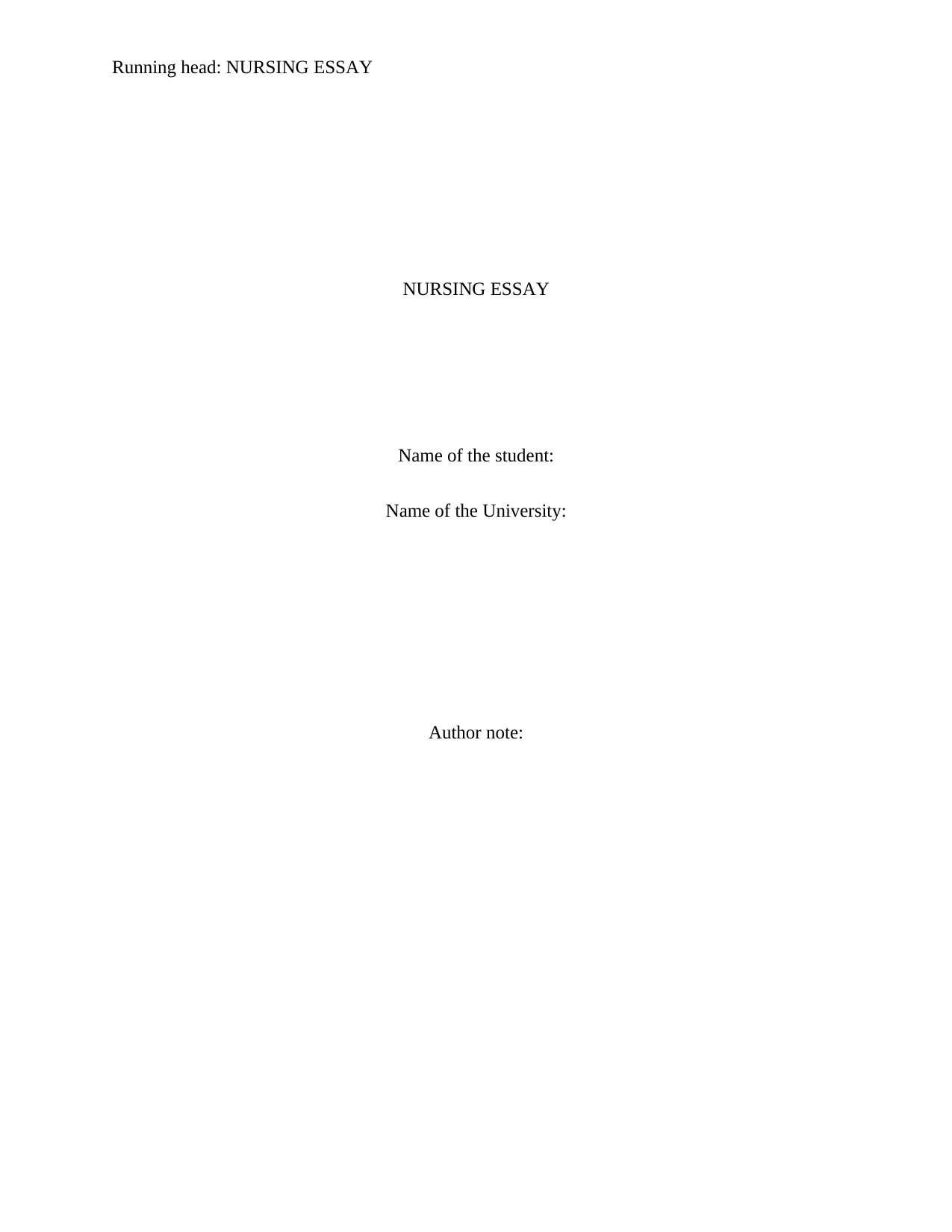
Running head: NURSING ESSAY
NURSING ESSAY
Name of the student:
Name of the University:
Author note:
NURSING ESSAY
Name of the student:
Name of the University:
Author note:
Paraphrase This Document
Need a fresh take? Get an instant paraphrase of this document with our AI Paraphraser
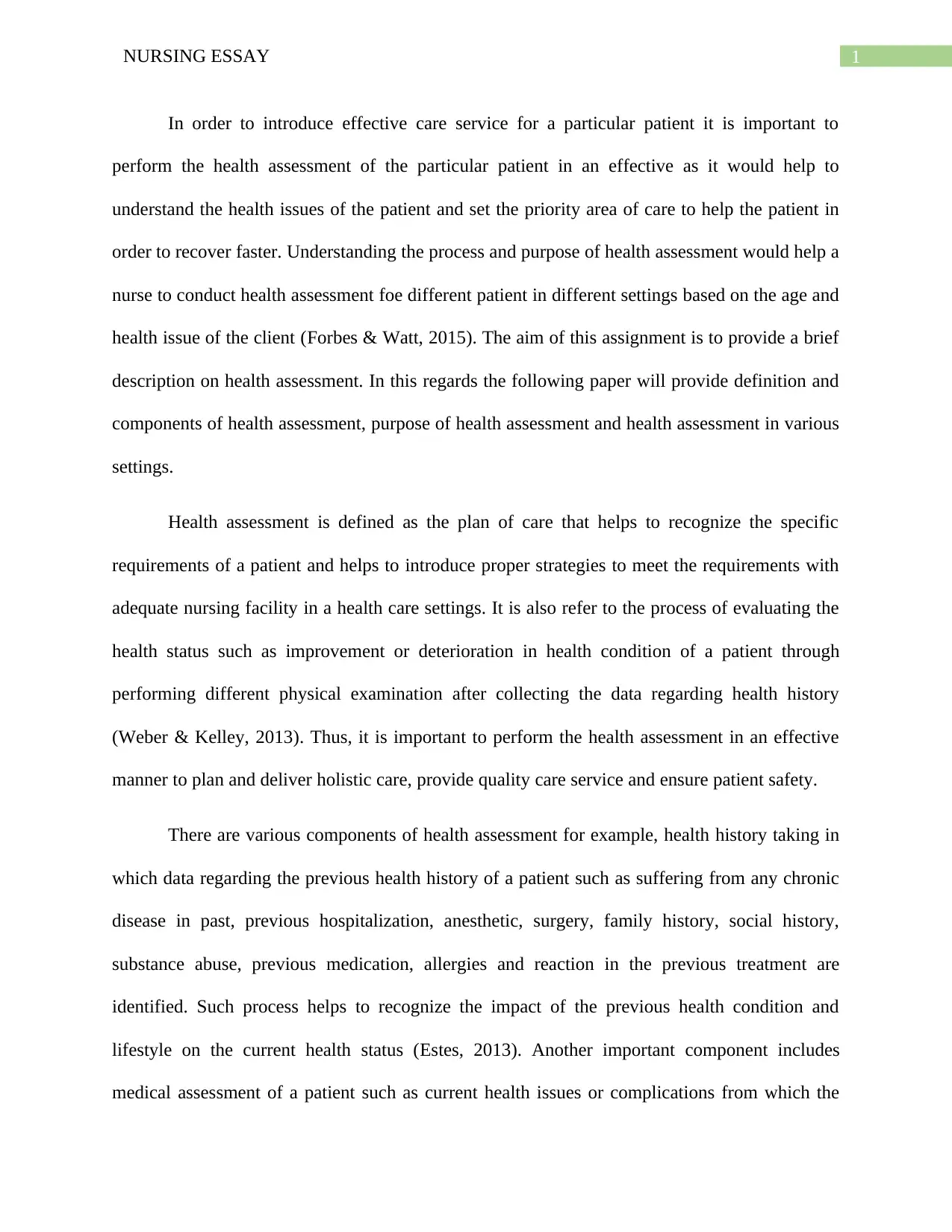
1NURSING ESSAY
In order to introduce effective care service for a particular patient it is important to
perform the health assessment of the particular patient in an effective as it would help to
understand the health issues of the patient and set the priority area of care to help the patient in
order to recover faster. Understanding the process and purpose of health assessment would help a
nurse to conduct health assessment foe different patient in different settings based on the age and
health issue of the client (Forbes & Watt, 2015). The aim of this assignment is to provide a brief
description on health assessment. In this regards the following paper will provide definition and
components of health assessment, purpose of health assessment and health assessment in various
settings.
Health assessment is defined as the plan of care that helps to recognize the specific
requirements of a patient and helps to introduce proper strategies to meet the requirements with
adequate nursing facility in a health care settings. It is also refer to the process of evaluating the
health status such as improvement or deterioration in health condition of a patient through
performing different physical examination after collecting the data regarding health history
(Weber & Kelley, 2013). Thus, it is important to perform the health assessment in an effective
manner to plan and deliver holistic care, provide quality care service and ensure patient safety.
There are various components of health assessment for example, health history taking in
which data regarding the previous health history of a patient such as suffering from any chronic
disease in past, previous hospitalization, anesthetic, surgery, family history, social history,
substance abuse, previous medication, allergies and reaction in the previous treatment are
identified. Such process helps to recognize the impact of the previous health condition and
lifestyle on the current health status (Estes, 2013). Another important component includes
medical assessment of a patient such as current health issues or complications from which the
In order to introduce effective care service for a particular patient it is important to
perform the health assessment of the particular patient in an effective as it would help to
understand the health issues of the patient and set the priority area of care to help the patient in
order to recover faster. Understanding the process and purpose of health assessment would help a
nurse to conduct health assessment foe different patient in different settings based on the age and
health issue of the client (Forbes & Watt, 2015). The aim of this assignment is to provide a brief
description on health assessment. In this regards the following paper will provide definition and
components of health assessment, purpose of health assessment and health assessment in various
settings.
Health assessment is defined as the plan of care that helps to recognize the specific
requirements of a patient and helps to introduce proper strategies to meet the requirements with
adequate nursing facility in a health care settings. It is also refer to the process of evaluating the
health status such as improvement or deterioration in health condition of a patient through
performing different physical examination after collecting the data regarding health history
(Weber & Kelley, 2013). Thus, it is important to perform the health assessment in an effective
manner to plan and deliver holistic care, provide quality care service and ensure patient safety.
There are various components of health assessment for example, health history taking in
which data regarding the previous health history of a patient such as suffering from any chronic
disease in past, previous hospitalization, anesthetic, surgery, family history, social history,
substance abuse, previous medication, allergies and reaction in the previous treatment are
identified. Such process helps to recognize the impact of the previous health condition and
lifestyle on the current health status (Estes, 2013). Another important component includes
medical assessment of a patient such as current health issues or complications from which the
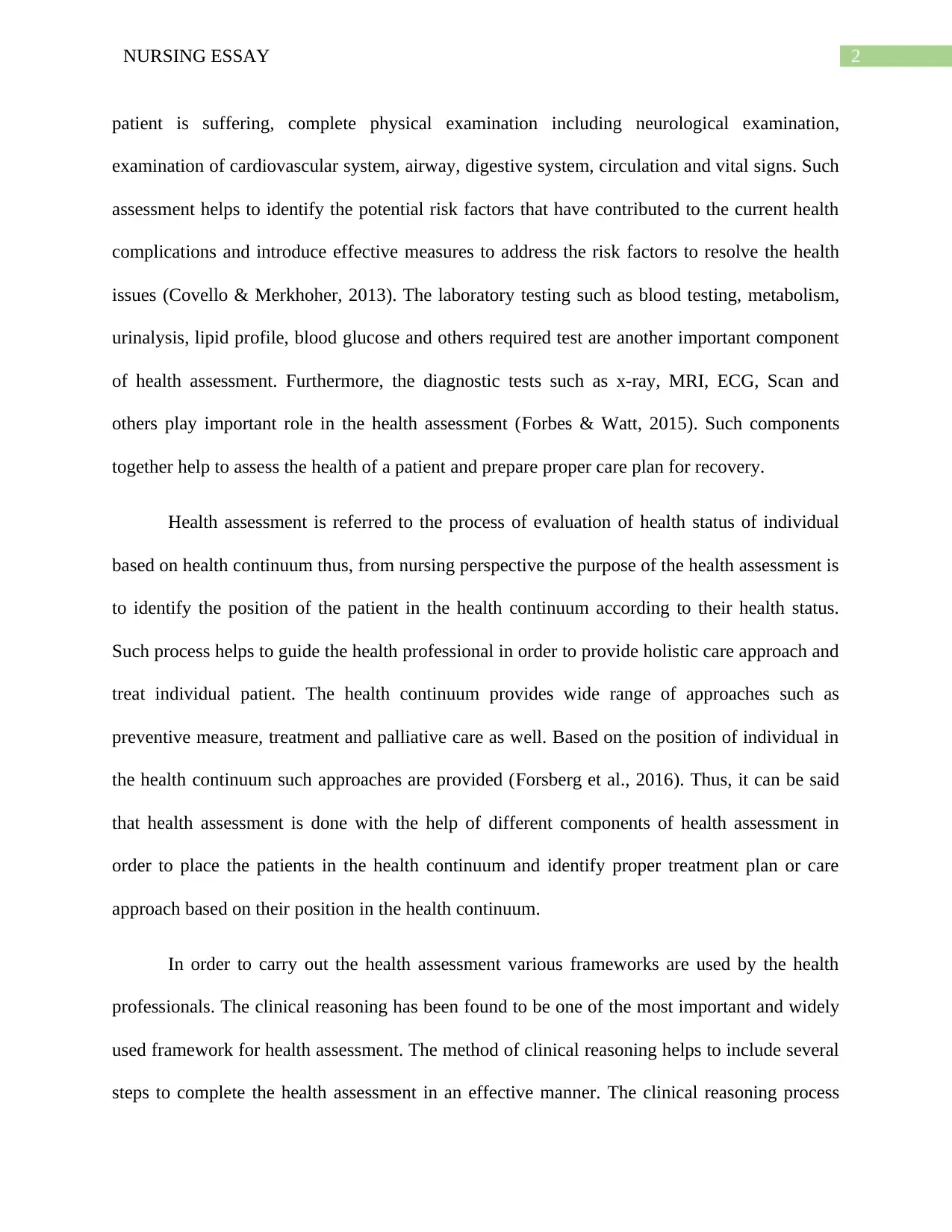
2NURSING ESSAY
patient is suffering, complete physical examination including neurological examination,
examination of cardiovascular system, airway, digestive system, circulation and vital signs. Such
assessment helps to identify the potential risk factors that have contributed to the current health
complications and introduce effective measures to address the risk factors to resolve the health
issues (Covello & Merkhoher, 2013). The laboratory testing such as blood testing, metabolism,
urinalysis, lipid profile, blood glucose and others required test are another important component
of health assessment. Furthermore, the diagnostic tests such as x-ray, MRI, ECG, Scan and
others play important role in the health assessment (Forbes & Watt, 2015). Such components
together help to assess the health of a patient and prepare proper care plan for recovery.
Health assessment is referred to the process of evaluation of health status of individual
based on health continuum thus, from nursing perspective the purpose of the health assessment is
to identify the position of the patient in the health continuum according to their health status.
Such process helps to guide the health professional in order to provide holistic care approach and
treat individual patient. The health continuum provides wide range of approaches such as
preventive measure, treatment and palliative care as well. Based on the position of individual in
the health continuum such approaches are provided (Forsberg et al., 2016). Thus, it can be said
that health assessment is done with the help of different components of health assessment in
order to place the patients in the health continuum and identify proper treatment plan or care
approach based on their position in the health continuum.
In order to carry out the health assessment various frameworks are used by the health
professionals. The clinical reasoning has been found to be one of the most important and widely
used framework for health assessment. The method of clinical reasoning helps to include several
steps to complete the health assessment in an effective manner. The clinical reasoning process
patient is suffering, complete physical examination including neurological examination,
examination of cardiovascular system, airway, digestive system, circulation and vital signs. Such
assessment helps to identify the potential risk factors that have contributed to the current health
complications and introduce effective measures to address the risk factors to resolve the health
issues (Covello & Merkhoher, 2013). The laboratory testing such as blood testing, metabolism,
urinalysis, lipid profile, blood glucose and others required test are another important component
of health assessment. Furthermore, the diagnostic tests such as x-ray, MRI, ECG, Scan and
others play important role in the health assessment (Forbes & Watt, 2015). Such components
together help to assess the health of a patient and prepare proper care plan for recovery.
Health assessment is referred to the process of evaluation of health status of individual
based on health continuum thus, from nursing perspective the purpose of the health assessment is
to identify the position of the patient in the health continuum according to their health status.
Such process helps to guide the health professional in order to provide holistic care approach and
treat individual patient. The health continuum provides wide range of approaches such as
preventive measure, treatment and palliative care as well. Based on the position of individual in
the health continuum such approaches are provided (Forsberg et al., 2016). Thus, it can be said
that health assessment is done with the help of different components of health assessment in
order to place the patients in the health continuum and identify proper treatment plan or care
approach based on their position in the health continuum.
In order to carry out the health assessment various frameworks are used by the health
professionals. The clinical reasoning has been found to be one of the most important and widely
used framework for health assessment. The method of clinical reasoning helps to include several
steps to complete the health assessment in an effective manner. The clinical reasoning process
⊘ This is a preview!⊘
Do you want full access?
Subscribe today to unlock all pages.

Trusted by 1+ million students worldwide
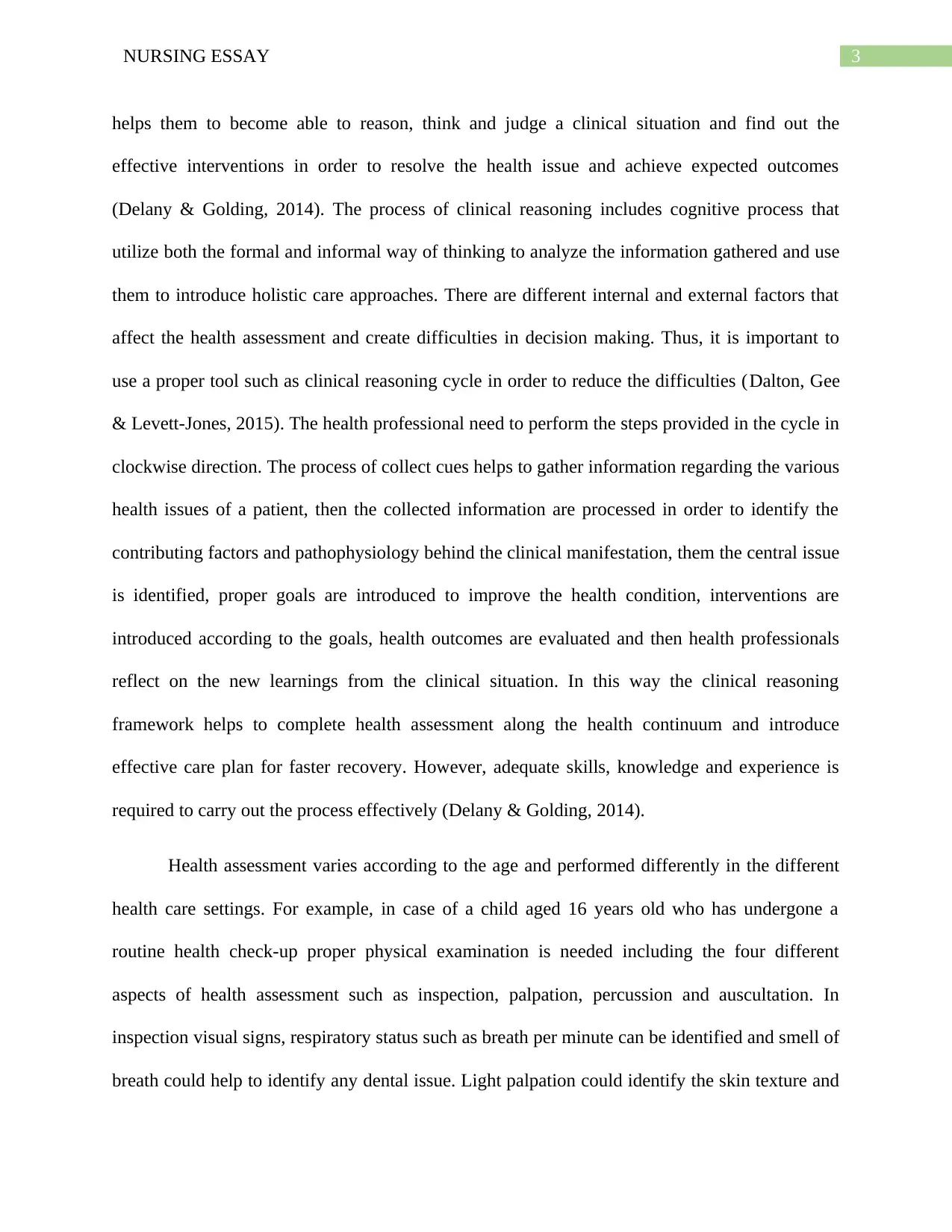
3NURSING ESSAY
helps them to become able to reason, think and judge a clinical situation and find out the
effective interventions in order to resolve the health issue and achieve expected outcomes
(Delany & Golding, 2014). The process of clinical reasoning includes cognitive process that
utilize both the formal and informal way of thinking to analyze the information gathered and use
them to introduce holistic care approaches. There are different internal and external factors that
affect the health assessment and create difficulties in decision making. Thus, it is important to
use a proper tool such as clinical reasoning cycle in order to reduce the difficulties (Dalton, Gee
& Levett-Jones, 2015). The health professional need to perform the steps provided in the cycle in
clockwise direction. The process of collect cues helps to gather information regarding the various
health issues of a patient, then the collected information are processed in order to identify the
contributing factors and pathophysiology behind the clinical manifestation, them the central issue
is identified, proper goals are introduced to improve the health condition, interventions are
introduced according to the goals, health outcomes are evaluated and then health professionals
reflect on the new learnings from the clinical situation. In this way the clinical reasoning
framework helps to complete health assessment along the health continuum and introduce
effective care plan for faster recovery. However, adequate skills, knowledge and experience is
required to carry out the process effectively (Delany & Golding, 2014).
Health assessment varies according to the age and performed differently in the different
health care settings. For example, in case of a child aged 16 years old who has undergone a
routine health check-up proper physical examination is needed including the four different
aspects of health assessment such as inspection, palpation, percussion and auscultation. In
inspection visual signs, respiratory status such as breath per minute can be identified and smell of
breath could help to identify any dental issue. Light palpation could identify the skin texture and
helps them to become able to reason, think and judge a clinical situation and find out the
effective interventions in order to resolve the health issue and achieve expected outcomes
(Delany & Golding, 2014). The process of clinical reasoning includes cognitive process that
utilize both the formal and informal way of thinking to analyze the information gathered and use
them to introduce holistic care approaches. There are different internal and external factors that
affect the health assessment and create difficulties in decision making. Thus, it is important to
use a proper tool such as clinical reasoning cycle in order to reduce the difficulties (Dalton, Gee
& Levett-Jones, 2015). The health professional need to perform the steps provided in the cycle in
clockwise direction. The process of collect cues helps to gather information regarding the various
health issues of a patient, then the collected information are processed in order to identify the
contributing factors and pathophysiology behind the clinical manifestation, them the central issue
is identified, proper goals are introduced to improve the health condition, interventions are
introduced according to the goals, health outcomes are evaluated and then health professionals
reflect on the new learnings from the clinical situation. In this way the clinical reasoning
framework helps to complete health assessment along the health continuum and introduce
effective care plan for faster recovery. However, adequate skills, knowledge and experience is
required to carry out the process effectively (Delany & Golding, 2014).
Health assessment varies according to the age and performed differently in the different
health care settings. For example, in case of a child aged 16 years old who has undergone a
routine health check-up proper physical examination is needed including the four different
aspects of health assessment such as inspection, palpation, percussion and auscultation. In
inspection visual signs, respiratory status such as breath per minute can be identified and smell of
breath could help to identify any dental issue. Light palpation could identify the skin texture and
Paraphrase This Document
Need a fresh take? Get an instant paraphrase of this document with our AI Paraphraser
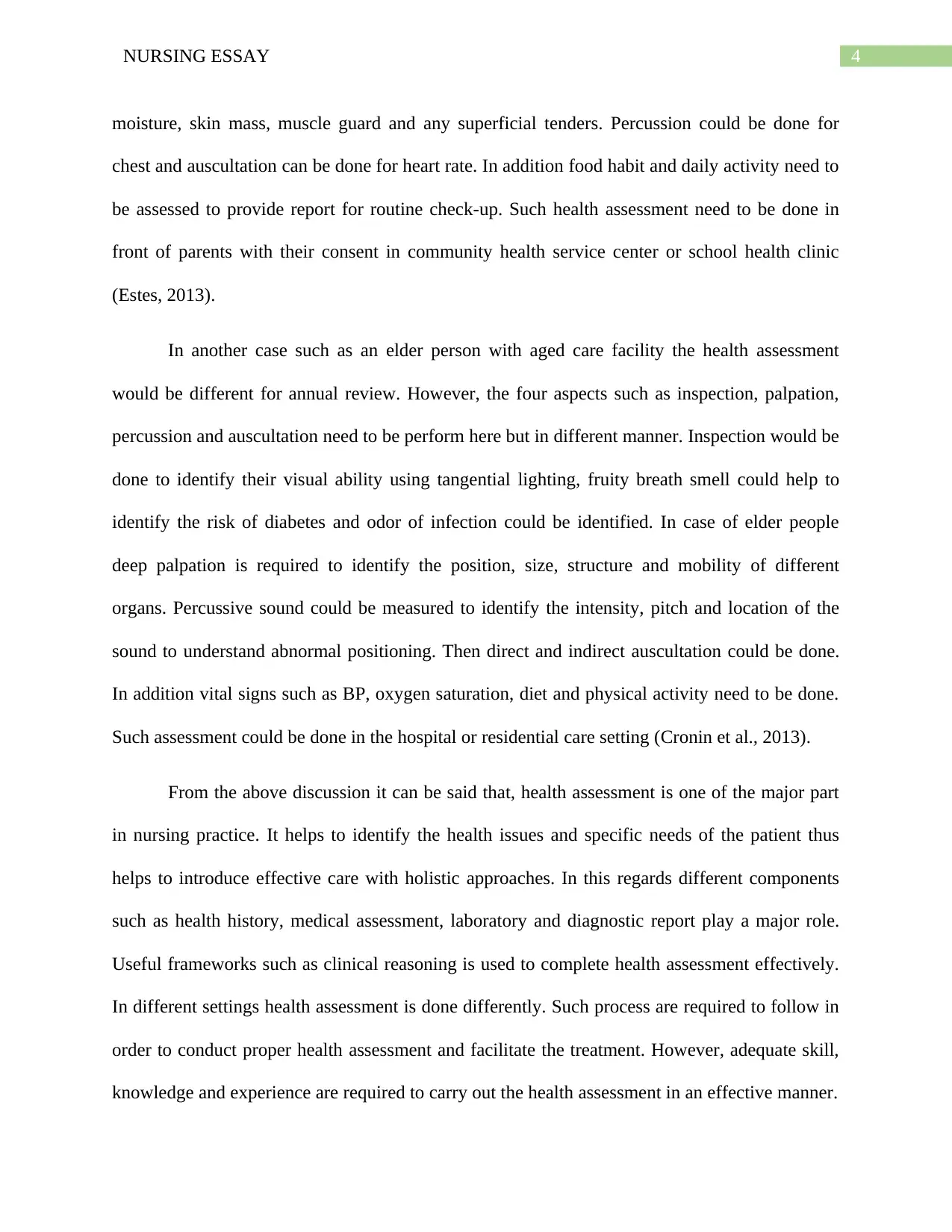
4NURSING ESSAY
moisture, skin mass, muscle guard and any superficial tenders. Percussion could be done for
chest and auscultation can be done for heart rate. In addition food habit and daily activity need to
be assessed to provide report for routine check-up. Such health assessment need to be done in
front of parents with their consent in community health service center or school health clinic
(Estes, 2013).
In another case such as an elder person with aged care facility the health assessment
would be different for annual review. However, the four aspects such as inspection, palpation,
percussion and auscultation need to be perform here but in different manner. Inspection would be
done to identify their visual ability using tangential lighting, fruity breath smell could help to
identify the risk of diabetes and odor of infection could be identified. In case of elder people
deep palpation is required to identify the position, size, structure and mobility of different
organs. Percussive sound could be measured to identify the intensity, pitch and location of the
sound to understand abnormal positioning. Then direct and indirect auscultation could be done.
In addition vital signs such as BP, oxygen saturation, diet and physical activity need to be done.
Such assessment could be done in the hospital or residential care setting (Cronin et al., 2013).
From the above discussion it can be said that, health assessment is one of the major part
in nursing practice. It helps to identify the health issues and specific needs of the patient thus
helps to introduce effective care with holistic approaches. In this regards different components
such as health history, medical assessment, laboratory and diagnostic report play a major role.
Useful frameworks such as clinical reasoning is used to complete health assessment effectively.
In different settings health assessment is done differently. Such process are required to follow in
order to conduct proper health assessment and facilitate the treatment. However, adequate skill,
knowledge and experience are required to carry out the health assessment in an effective manner.
moisture, skin mass, muscle guard and any superficial tenders. Percussion could be done for
chest and auscultation can be done for heart rate. In addition food habit and daily activity need to
be assessed to provide report for routine check-up. Such health assessment need to be done in
front of parents with their consent in community health service center or school health clinic
(Estes, 2013).
In another case such as an elder person with aged care facility the health assessment
would be different for annual review. However, the four aspects such as inspection, palpation,
percussion and auscultation need to be perform here but in different manner. Inspection would be
done to identify their visual ability using tangential lighting, fruity breath smell could help to
identify the risk of diabetes and odor of infection could be identified. In case of elder people
deep palpation is required to identify the position, size, structure and mobility of different
organs. Percussive sound could be measured to identify the intensity, pitch and location of the
sound to understand abnormal positioning. Then direct and indirect auscultation could be done.
In addition vital signs such as BP, oxygen saturation, diet and physical activity need to be done.
Such assessment could be done in the hospital or residential care setting (Cronin et al., 2013).
From the above discussion it can be said that, health assessment is one of the major part
in nursing practice. It helps to identify the health issues and specific needs of the patient thus
helps to introduce effective care with holistic approaches. In this regards different components
such as health history, medical assessment, laboratory and diagnostic report play a major role.
Useful frameworks such as clinical reasoning is used to complete health assessment effectively.
In different settings health assessment is done differently. Such process are required to follow in
order to conduct proper health assessment and facilitate the treatment. However, adequate skill,
knowledge and experience are required to carry out the health assessment in an effective manner.
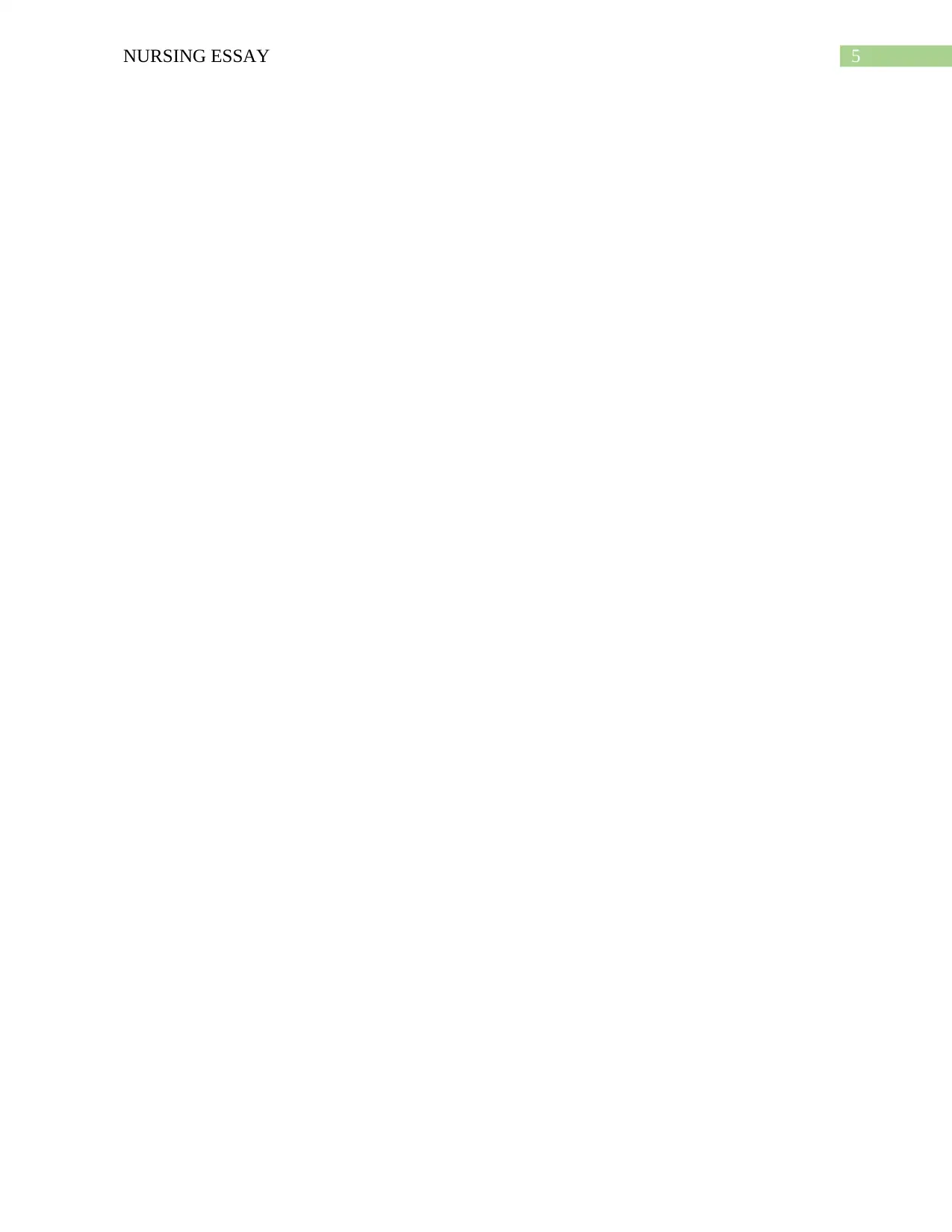
5NURSING ESSAY
⊘ This is a preview!⊘
Do you want full access?
Subscribe today to unlock all pages.

Trusted by 1+ million students worldwide
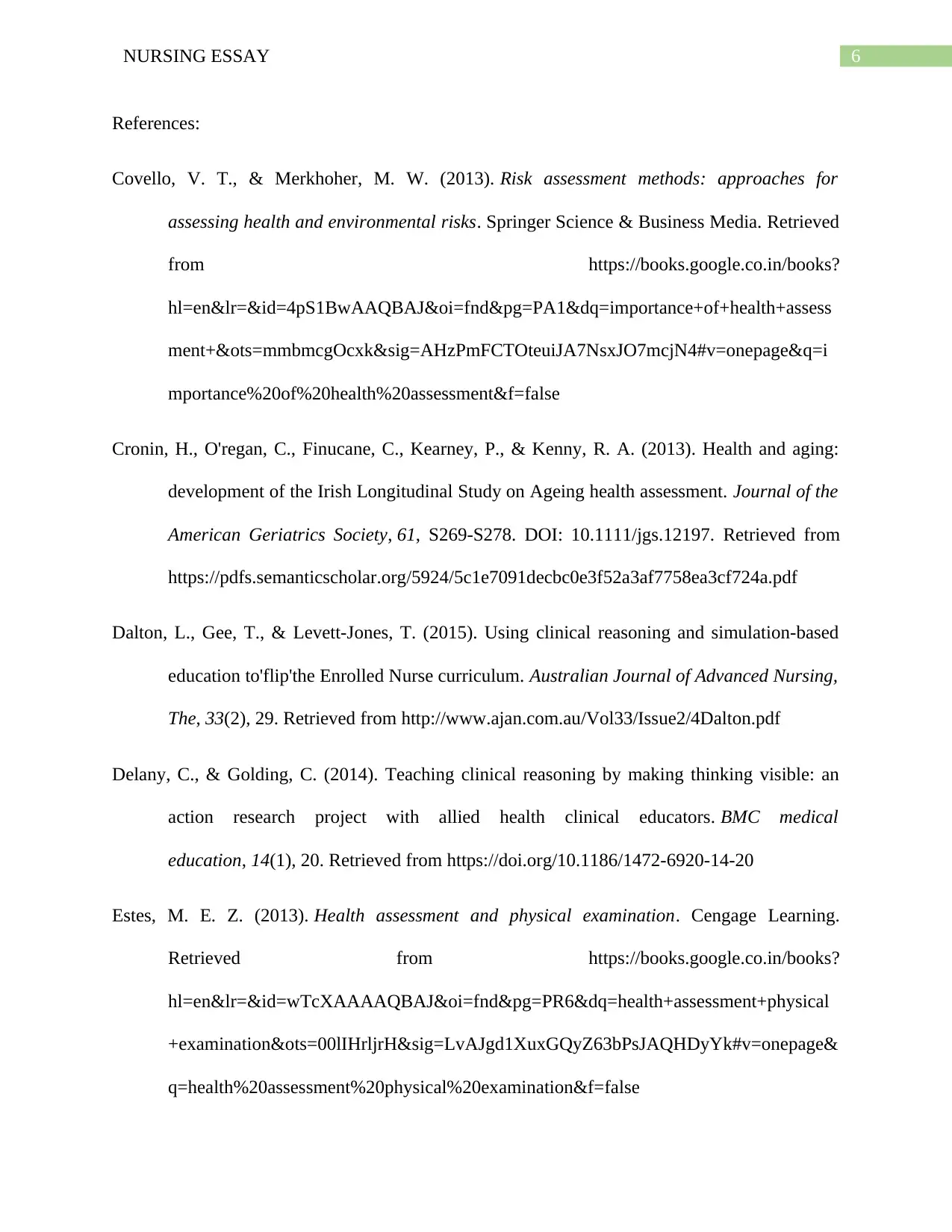
6NURSING ESSAY
References:
Covello, V. T., & Merkhoher, M. W. (2013). Risk assessment methods: approaches for
assessing health and environmental risks. Springer Science & Business Media. Retrieved
from https://books.google.co.in/books?
hl=en&lr=&id=4pS1BwAAQBAJ&oi=fnd&pg=PA1&dq=importance+of+health+assess
ment+&ots=mmbmcgOcxk&sig=AHzPmFCTOteuiJA7NsxJO7mcjN4#v=onepage&q=i
mportance%20of%20health%20assessment&f=false
Cronin, H., O'regan, C., Finucane, C., Kearney, P., & Kenny, R. A. (2013). Health and aging:
development of the Irish Longitudinal Study on Ageing health assessment. Journal of the
American Geriatrics Society, 61, S269-S278. DOI: 10.1111/jgs.12197. Retrieved from
https://pdfs.semanticscholar.org/5924/5c1e7091decbc0e3f52a3af7758ea3cf724a.pdf
Dalton, L., Gee, T., & Levett-Jones, T. (2015). Using clinical reasoning and simulation-based
education to'flip'the Enrolled Nurse curriculum. Australian Journal of Advanced Nursing,
The, 33(2), 29. Retrieved from http://www.ajan.com.au/Vol33/Issue2/4Dalton.pdf
Delany, C., & Golding, C. (2014). Teaching clinical reasoning by making thinking visible: an
action research project with allied health clinical educators. BMC medical
education, 14(1), 20. Retrieved from https://doi.org/10.1186/1472-6920-14-20
Estes, M. E. Z. (2013). Health assessment and physical examination. Cengage Learning.
Retrieved from https://books.google.co.in/books?
hl=en&lr=&id=wTcXAAAAQBAJ&oi=fnd&pg=PR6&dq=health+assessment+physical
+examination&ots=00lIHrljrH&sig=LvAJgd1XuxGQyZ63bPsJAQHDyYk#v=onepage&
q=health%20assessment%20physical%20examination&f=false
References:
Covello, V. T., & Merkhoher, M. W. (2013). Risk assessment methods: approaches for
assessing health and environmental risks. Springer Science & Business Media. Retrieved
from https://books.google.co.in/books?
hl=en&lr=&id=4pS1BwAAQBAJ&oi=fnd&pg=PA1&dq=importance+of+health+assess
ment+&ots=mmbmcgOcxk&sig=AHzPmFCTOteuiJA7NsxJO7mcjN4#v=onepage&q=i
mportance%20of%20health%20assessment&f=false
Cronin, H., O'regan, C., Finucane, C., Kearney, P., & Kenny, R. A. (2013). Health and aging:
development of the Irish Longitudinal Study on Ageing health assessment. Journal of the
American Geriatrics Society, 61, S269-S278. DOI: 10.1111/jgs.12197. Retrieved from
https://pdfs.semanticscholar.org/5924/5c1e7091decbc0e3f52a3af7758ea3cf724a.pdf
Dalton, L., Gee, T., & Levett-Jones, T. (2015). Using clinical reasoning and simulation-based
education to'flip'the Enrolled Nurse curriculum. Australian Journal of Advanced Nursing,
The, 33(2), 29. Retrieved from http://www.ajan.com.au/Vol33/Issue2/4Dalton.pdf
Delany, C., & Golding, C. (2014). Teaching clinical reasoning by making thinking visible: an
action research project with allied health clinical educators. BMC medical
education, 14(1), 20. Retrieved from https://doi.org/10.1186/1472-6920-14-20
Estes, M. E. Z. (2013). Health assessment and physical examination. Cengage Learning.
Retrieved from https://books.google.co.in/books?
hl=en&lr=&id=wTcXAAAAQBAJ&oi=fnd&pg=PR6&dq=health+assessment+physical
+examination&ots=00lIHrljrH&sig=LvAJgd1XuxGQyZ63bPsJAQHDyYk#v=onepage&
q=health%20assessment%20physical%20examination&f=false
Paraphrase This Document
Need a fresh take? Get an instant paraphrase of this document with our AI Paraphraser
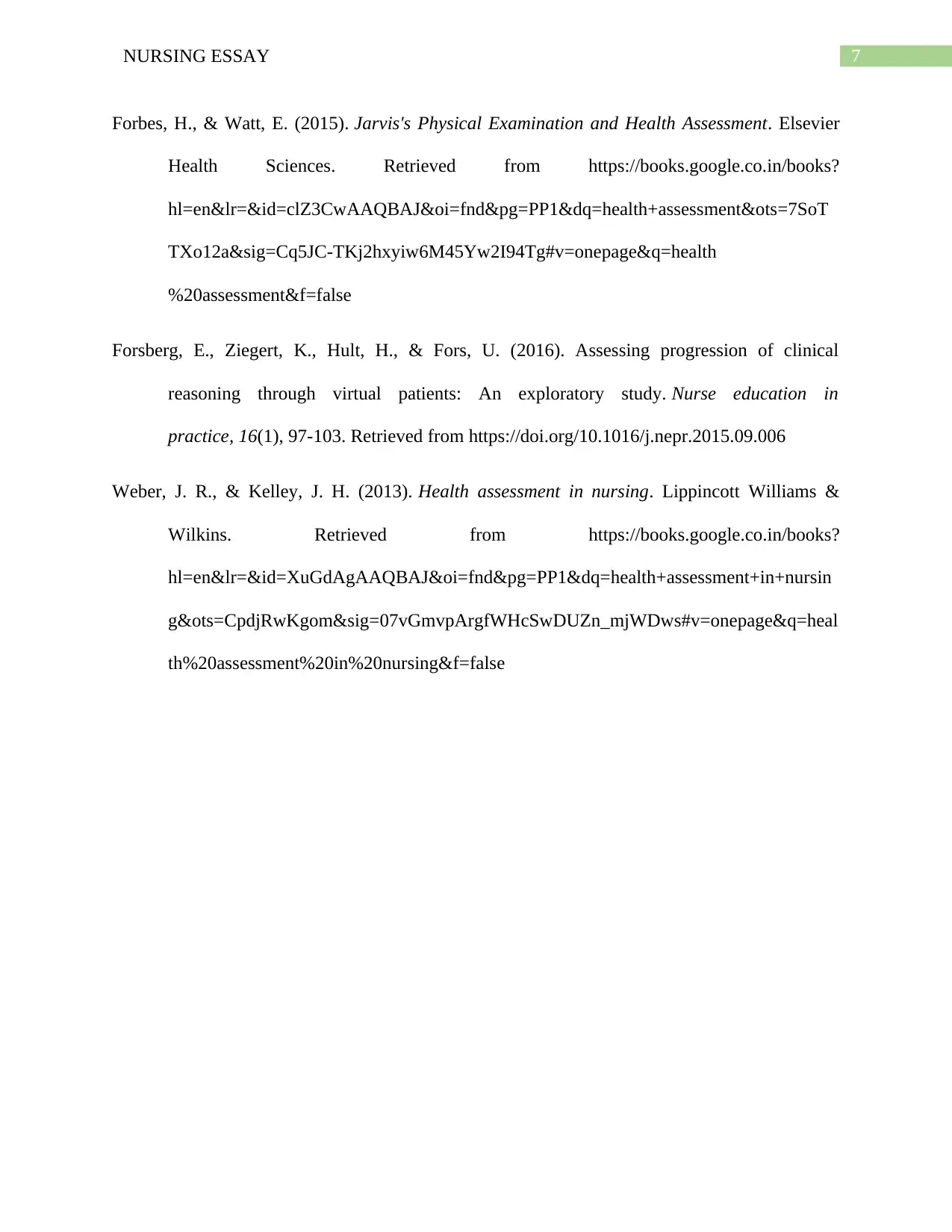
7NURSING ESSAY
Forbes, H., & Watt, E. (2015). Jarvis's Physical Examination and Health Assessment. Elsevier
Health Sciences. Retrieved from https://books.google.co.in/books?
hl=en&lr=&id=clZ3CwAAQBAJ&oi=fnd&pg=PP1&dq=health+assessment&ots=7SoT
TXo12a&sig=Cq5JC-TKj2hxyiw6M45Yw2I94Tg#v=onepage&q=health
%20assessment&f=false
Forsberg, E., Ziegert, K., Hult, H., & Fors, U. (2016). Assessing progression of clinical
reasoning through virtual patients: An exploratory study. Nurse education in
practice, 16(1), 97-103. Retrieved from https://doi.org/10.1016/j.nepr.2015.09.006
Weber, J. R., & Kelley, J. H. (2013). Health assessment in nursing. Lippincott Williams &
Wilkins. Retrieved from https://books.google.co.in/books?
hl=en&lr=&id=XuGdAgAAQBAJ&oi=fnd&pg=PP1&dq=health+assessment+in+nursin
g&ots=CpdjRwKgom&sig=07vGmvpArgfWHcSwDUZn_mjWDws#v=onepage&q=heal
th%20assessment%20in%20nursing&f=false
Forbes, H., & Watt, E. (2015). Jarvis's Physical Examination and Health Assessment. Elsevier
Health Sciences. Retrieved from https://books.google.co.in/books?
hl=en&lr=&id=clZ3CwAAQBAJ&oi=fnd&pg=PP1&dq=health+assessment&ots=7SoT
TXo12a&sig=Cq5JC-TKj2hxyiw6M45Yw2I94Tg#v=onepage&q=health
%20assessment&f=false
Forsberg, E., Ziegert, K., Hult, H., & Fors, U. (2016). Assessing progression of clinical
reasoning through virtual patients: An exploratory study. Nurse education in
practice, 16(1), 97-103. Retrieved from https://doi.org/10.1016/j.nepr.2015.09.006
Weber, J. R., & Kelley, J. H. (2013). Health assessment in nursing. Lippincott Williams &
Wilkins. Retrieved from https://books.google.co.in/books?
hl=en&lr=&id=XuGdAgAAQBAJ&oi=fnd&pg=PP1&dq=health+assessment+in+nursin
g&ots=CpdjRwKgom&sig=07vGmvpArgfWHcSwDUZn_mjWDws#v=onepage&q=heal
th%20assessment%20in%20nursing&f=false
1 out of 8
Related Documents
Your All-in-One AI-Powered Toolkit for Academic Success.
+13062052269
info@desklib.com
Available 24*7 on WhatsApp / Email
![[object Object]](/_next/static/media/star-bottom.7253800d.svg)
Unlock your academic potential
Copyright © 2020–2025 A2Z Services. All Rights Reserved. Developed and managed by ZUCOL.




